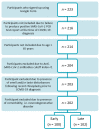Assessment of Smell and Taste Disturbances among COVID-19 Convalescent Patients: A Cross-Sectional Study in Armenia
- PMID: 35743383
- PMCID: PMC9224774
- DOI: 10.3390/jcm11123313
Assessment of Smell and Taste Disturbances among COVID-19 Convalescent Patients: A Cross-Sectional Study in Armenia
Abstract
Background and objectives: Neurological manifestations of Coronavirus Disease 2019 (COVID-19) such as olfactory and gustatory disturbance have been reported among convalescent COVID-19 patients. However, scientific data on the prevalence of smell and taste disturbance are lacking. Therefore, we present findings on the degree of smell and taste disturbances among the Armenian population.
Methods: Study participants were randomly recruited and then categorized into two groups based on their course of the disease. A cross-sectional study was performed to assess participants' sensitivity to smell triggered by the olfactory and the trigeminal nerves; their ability to differentiate between various odors; and to evaluate their gustatory perception.
Results: The smell test revealed that the degree of olfactory nerve disturbance was different by 30.7% in those participants of the early group as compared to those of the late group, and the degree of trigeminal nerve disturbance was different by 71.3% in the early group as compared to the late group. A variation of the differentiating ability among the participants of the early and late groups was detected. Gustatory disturbances for all flavors were also found to be different in both the groups. A moderate positive correlation (0.51) was found between the overall sensitivity of smell and the ability to differentiate between various odors as cumulatively stimulated by both the olfactory and trigeminal nerves. Also, a moderate positive correlation (0.33) was found between headache and smell sensitivity through the olfactory nerve and a high negative correlation (-0.71) was found between headache and smell sensitivity through the trigeminal nerve.
Conclusion: Pathological changes in the olfactory and trigeminal perceptive abilities caused disturbances in smell sensation, with the trigeminal nerve being more affected. The capacity to differentiate fragrances did not improve with time and the disturbance severity of bitter taste perception was higher among the study participants.
Keywords: COVID-19; diagnostic marker; headache; neurosensory dysfunction; olfactory nerve; smell disturbances; taste disturbances; trigeminal nerve.
Conflict of interest statement
Darshan Shingala is currently working at ClinChoice LLC, and is also involved with this study as a researcher. Karen Mkrtumyan is an employee of Krisp Technologies Inc and joined our research team as secondary statistician. There is no conflict of interests between any authors and their respective employer.
Figures











Similar articles
-
Smell, taste and trigeminal disorders in a 65-year-old population.BMC Geriatr. 2021 May 8;21(1):300. doi: 10.1186/s12877-021-02242-6. BMC Geriatr. 2021. PMID: 33964881 Free PMC article.
-
Chemosensory decrease in different forms of olfactory dysfunction.J Neurol. 2020 Jan;267(1):138-143. doi: 10.1007/s00415-019-09564-x. Epub 2019 Oct 4. J Neurol. 2020. PMID: 31586261
-
Electrophysiological evidence of subclinical trigeminal dysfunction in patients with COVID-19 and smell impairment: A pilot study.Front Neurol. 2022 Oct 14;13:981888. doi: 10.3389/fneur.2022.981888. eCollection 2022. Front Neurol. 2022. PMID: 36313508 Free PMC article.
-
Chemosensory dysfunction in primary Sjögren's syndrome: a topical review.Clin Rheumatol. 2023 Jan;42(1):1-14. doi: 10.1007/s10067-022-06359-w. Epub 2022 Sep 5. Clin Rheumatol. 2023. PMID: 36063255 Free PMC article. Review.
-
Self-reported olfactory and gustatory dysfunction and psychophysical testing in screening for COVID-19: A systematic review and meta-analysis.Int Forum Allergy Rhinol. 2022 May;12(5):744-756. doi: 10.1002/alr.22923. Epub 2021 Dec 6. Int Forum Allergy Rhinol. 2022. PMID: 34725952 Free PMC article.
Cited by
-
Exploring the research landscape of COVID-19-induced olfactory dysfunction: A bibliometric study.Front Neurosci. 2023 Mar 24;17:1164901. doi: 10.3389/fnins.2023.1164901. eCollection 2023. Front Neurosci. 2023. PMID: 37034158 Free PMC article. Review.
References
Grants and funding
LinkOut - more resources
Full Text Sources

